
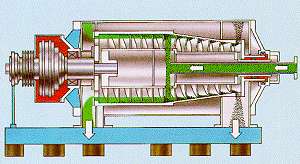
Optimization of a Water Treatment System
by C. von Altrock and Bernhard Krause
Citation Reference: This paper was published at the Fuzzy Logic '94 Conference held in San Francisco in September 1994. The Fuzzy Logic Application Note series is published by Inform Software Corporation on its Internet server to promote the use of fuzzy logic technologies in applications.
This case study is about a fuzzy logic solution in biochemical production at the world's largest oral penicillin production facility in Austria. After extracting the penicillin from the microorganisms that generated it, a waste water treatment system further processes the remaining biomass. Fermentation sludge obtained in the course of this treatment contains microorganisms and remnants of nutrient salts. It is the basic material for a high quality fertilizer and sold as a by-product of the penicillin production. To render the fertilizer, the sludge is concentrated in a decanter and then cleared of the remaining water in a vaporizer. In order to reduce energy costs of the vaporizing process, the separation of water and dry substance in the decanter must be optimized. Before the implementation of the fuzzy logic solution, operators controlled the process manually.
1. Fuzzy Logic Replaces Manual Control
Due to its complexity, operators control the process of proportioning decanter precipitants manually. Drainage control in the decanter is very crucial. To save energy cost in the vaporizing process, the decanter must extract as much water as possible. However, to achieve optimal results requires an operating point close to the point where the decanter becomes blocked. If blockage occurs the process must be stopped and the decanter manually cleaned, thus operators run the process far away from this optimal point. Alas, this results in high operational energy costs. In this case study, a fuzzy logic system replaced the sub-optimal manual control of the operators.
 |
Picture of a Decanter |
 |
Schematic . |
2. Fuzzy Logic Applications in Chemical Industry
A number of conventional control techniques exist to automate continuous processes in chemical industry. To keep single variables of the process constant, PID controllers or the like are very common. Even though, most technical processes are non-linear and PID controllers are a linear model, this works fine. This is because within a continuous process, the behavior of the process can be well-approximated linearly near the operation point. In processes with simple time behavior (no dead times etc.), even P (proportional) controllers and bang-bang controllers often suffice.
 |
Figure 1: Using a Fuzzy Logic Controller to Determine the Set Values for Underlying PID Control Loops |
While keeping single process variables at their command values is rather simple, the determination of the optimal operation point as the combination of all set values of the variables is often a complex multi-variable problem. In most cases a solution based on a mathematical model of the process is far beyond acceptable complexity. In some cases, the derivation of a mathematical model of the plant consumes many man years of effort. Hence, in a large number of plants, operators prefer to control the operation point of the process manually.
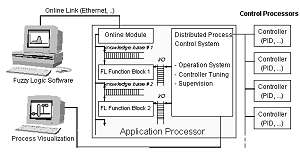 |
Figure 2: Integration of a Fuzzy Logic Component in a Distributed Control System |
In these cases, fuzzy logic provides an efficient technology for putting the operator control strategies into an automation solution with minimum effort [1, 2, 8, 9]. Figure 1 shows how to combine the fuzzy logic system with underlying PID controllers. In practical implementations, the PID controllers run on the same Distributed Process Control Systems (DCS) as the fuzzy logic controller. Figure 2 shows the technical integration of fuzzy logic into DCS.
3. Decanter Control
The sewage of the fermenters contains about 2% dry substance. In a first step, milk of lime neutralizes the sewage. Second, a fermenter biologically degrades the sewage. Third, bentonite is added in a large reactor. This results in a pre-coagulation of the sludge. Next, the slurry is enriched with cationic polymer before the water is separated in the decanter. The cationic polymer discharges the surface charge of the sludge particles and hence leads to coagulation.
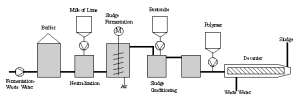 |
Figure 3: Process Diagram of Sludge Draining |
Bentonite and polymer addition exert a fundamental influence on the drainage quality obtained in the decanter. In order to achieve a high drainage quality, the gradation of chemicals has to be optimized. A changed bentonite proportioning causes only a slow change in the precipitation process because of the dead time of the reactor of about 20 minutes (reactor capacity 30 m 3 at a volume flow of 90 m 3 /h) and the dead time of the decanter of about 5 to 7 minutes. An increase in bentonite addition principally results in an improvement of coagulation. Implementation of just a polymer proportioning controller must only consider the dead time of the decanter. An increase in polymer addition first results in an improvement of coagulation, but with further addition coagulation impairs.
The control strategy of the operators uses two measured variables:
- A turbidity meter measures the purity of the water. High turbidity indicates a high remaining solids content of the water.
- A conductivity meter measured the draining degree of the slurry. A high conductivity of the slurry indicates a high water content.
4. Control Strategy Objectives
The prime objective of the control strategy is to minimize the operational cost of the total drying process. In particular, the objectives are:
The third objective has an absolute priority, above other objectives, to ensure safe operation. If the biological mass content reaches its upper limits, the control strategy reduces it regardless of economic considerations. Besides the critical biological mass content of the sewage water, only the first two objectives are relevant. A rough cost estimation shows that the most effective way to reduce the expenses of the process is to minimize the energy used in the evaporators. If the dry substance content of the thick slurry is increased by 1% (this corresponds to a change of conductivity of about 0.5 mS/cm), the costs of energy (used in the evaporator) could be reduced by $140 per day. A reduction of bentonite addition by 10% saves about $30 per day, and a decrease of polymer addition by 10% reduces costs by $40 per day. A small decrease of chemical gradation can result in a significant reduction of dry substance contents in thick slurry. Therefore the main objective of optimization is to obtain the best possible result of draining with least use of chemicals.
5. Designing the Fuzzy Logic Rule Base
An increase of polymer addition results in an increase of drainage grade. This reduces the turbidity of the sewage water (degree of suspended matter) and conductivity of the thick slurry (water content). Exceeding the optimum polymer gradation, further addition of polymer leads to a decline of the separation power in the decanter. The separation power on polymer gradation L=f(dmpolymer/dt) follows a parabolic curve (Figure 4). Conductivity of the slurry is used as an indicator for the separation power obtained. Hence, the control strategy is to find the minimum of conductivity by modifying the polymer addition.
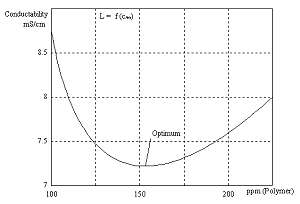 |
Figure 4: Thick Slurry Conductivity Over Polymer Proportion |
The problem with this is that the shape of the curve and hence also the level and position of the minimum may significantly vary over time. The only way to find out the direction to the minimum from the current operating point is to apply a change in the polymer gradation and evaluate its effects. If the draining of thick slurry improves, the conclusion is that this decision was correct and can be repeated. If the decision results in a decline, the fuzzy logic controller pursues the opposite strategy. The stronger the system's reaction to a change in polymer addition is, the greater is the current operation point's distance to the optimum.
Likewise, an increase in bentonite addition leads to an increase in separation power of the decanter until an optimum is reached. If more bentonite is added beyond this point, neither improvement nor decline occurs. Thus, an increase in bentonite addition beyond the optimal point is less critical than an increase in polymer addition. However, bentonite addition should be kept as low as possible to minimize operating cost.
6. Structure of the Decanter Controller
A change in bentonite addition has a greater long-term effect than a change in polymer addition, due to the larger dead time. As a correlation between bentonite and polymer addition exists, it is sensible to change the polymer addition independent of the separation quality in the short term and to let the bentonite controller run with delay.
Sewage quality is only restricted by an upper limit, whereas slurry quality is of great economical importance. For these reasons, polymer addition is controlled by a first set of rules in correlation to the slurry quality. An absolute point of reference does not exist because of the changing optimum of the polymer addition characteristics. Hence, no absolute input or output values are used. The controller determines its position in the objective function from a prior change in polymer addition and the resulting reaction of conductivity.
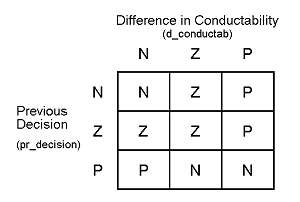 |
Figure 5: Matrix Representing the Control Strategy of Polymer Proportion. N Represents "negative", Z Represents "zero", and P Represents "positive" |
The first rule block of the fuzzy logic controller works on the targeting. Input values for this rule block are the increment of set point in the previous cycle (pr_decision) and the resulting change in conductivity (d_conductab). The output of the rule block is the increment (polymer1) on the set point of the polymer PID controller. Figure 5 shows the control strategy of this rule block as a matrix. The entries in the matrix represent the output variable polymer1 of the rule block.
A positive change in conductivity implies a decline of the plant's operating state. If the controller in the previous cycle (pr_decision) recommended "negative" (reduce polymer addition) and conductivity increased as a reaction to this, the controller must now operate in the opposite direction and increase polymer addition. If the controller recommended "positive", polymer addition must be reduced. Conductivity may increase although the controller has not given a recommendation in the previous cycle (pr_decision = 0). In this case, the optimum moved by external influence and action must be taken.
As the fuzzy logic controller does not know in which direction the optimum moved, it has to choose one direction. For this, it increases polymer addition to test the reaction of the process. It tests with a polymer increase rather then a decrease, as the curve in the figure rises more gently into the positive direction, and an increased use of polymer is cheaper than the raised energy costs that stem from the evaporation process.
If the test result is favorable, this will be confirmed in the next cycle. If it is negative, the controller will simply change the signs of the output in the subsequent cycle (see matrix in Figure 5). This only represents the basic principle of the rule block. The final implementation of the rule block contains additional rules that more finely differentiate the input value. As such, the fuzzy logic controller can differentiate between several cases and thus adapt the size of gradation change to the reaction of the process that is, to the proximity to the optimum.
The turbidity of the sewage water forms a restriction that in some cases forbids the reduction of the precipitant addition. Therefore, a second rule block evaluates the turbidity of the sewage water (turbidity) and the output of the first rule block (polymer1) to determine the final polymer addition increment (polymer2). Figure 6 shows the structure of the fuzzy logic system. As long as turbidity units are below 2500 TE/F, the second rule block transfers the first block's recommendation to the output. Starting at about 3000 TE/F, all recommendations of the first rule block are transferred, except recommendations to reduce polymer addition. If about 3500 TE/F are exceeded, the second rule block always recommends an increase of flocculent addition. Only the rate of increase of flocculent addition changes, depending on the recommendation of the first rule block.
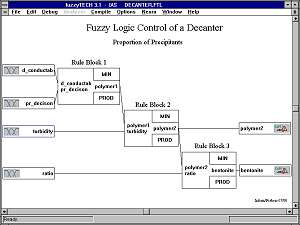 |
Figure 6: Structure of the Fuzzy Logic Controller |
To determine the betonite addition, a third rule block uses the output of the second rule block and a fourth input variable, called ration. The ratio is calculated outside the fuzzy logic system.
7. Integrating the Fuzzy Logic Controller in the System
Figure 7 shows the total structure of the entire control system. In addition to the fuzzy logic system, function blocks (CALC, RATIO) provide preprocessing of the sensor signals, ramp generation, and ratio control. The entire control system is implemented using a standard distributed process control system (DCS).
The most important input variable of the controller is the change in the conductivity of the slurry. Alas, the conductivity measurement circuitry is subject to strong signal noise. Hence, a low pass filter is used that determines the average change in conductivity during the last ten minutes at one minute intervals. This forms the input variable d_conductab of the fuzzy logic system. Turbidity, the fuzzy system's second input, uses a similar filter.
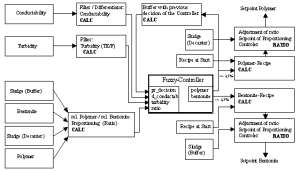 |
Figure 7: Total Controller Structure with Preprocessing and Postprocessing |
8. Results
About two months of engineering effort was required to develop the application. Compared to the manual operation, the fuzzy logic controller saves about $70,000 in energy costs per year.
9. Literature
| [1] | Evans, G.W., Karowski, W. and Wilhelm, M.R., "Application of fuzzy set methodologies in industrial engineering", Amsterdam, Oxford, New York, Tokyo (1989). |
| [2] | Hanakuma, Y. et. al., "Ethylen plant distillation column bottom temperature control", Keisi Vol. 32, No. 8 (1989), p. 28 - 39. |
| [3] | N.N., " fuzzy TECH 4.2 Online Edition Manual", INFORM GmbH Aachen / Inform Software Corp., Chicago (1996). |
| [4] | N.N., " fuzzy TECH 4.2 PLC Edition Manual", INFORM GmbH Aachen / Inform Software Corp., Chicago (1996). |
| [5] | N.N., " fuzzy TECH 4.2 IAS Edition Manual", INFORM GmbH Aachen / Inform Software Corp., Chicago (1996). |
| [6] | N.N., " fuzzy TECH 4.2 NeuroFuzzy Module Manual", INFORM GmbH Aachen / Inform Software Corp., Chicago (1996). |
| [7] | N.N., " fuzzy TECH 4.2 DataAnalyzer Module Manual", INFORM GmbH Aachen / Inform Software Corp., Chicago (1996). |
| [8] | Roffel, B. and Chin, P.A., "Fuzzy control of a polymerization reactor", Hydrocarbon Processing, June (1991), p. 47 - 50. |
| [9] | Tobi, T. and Hanafusa, T., "A practical application of fuzzy control for an air-conditioning system", International Journal of Approximate Reasoning 5 (1991), p. 331 - 348. |
| [10] | von Altrock, C., Krause, B., Limper, K. and Schäfers, W., "Optimization of a Waste Incineration Plant Using Fuzzy Logic", EUFIT '94 Conference in Aachen (1994). |
| [11] | von Altrock, "Fuzzy Logic and NeuroFuzzy Applications Explained", Prentice Hall (1995). |
| [12] | von Altrock, C., Arend, H.-O., Krause, B., Steffens, C., and Behrens-Rommler, E., "Customer-Adaptive Fuzzy Control of Home Heating System", IEEE Conference on Fuzzy Systems in Orlando (1994). |
| [13] | Zimmermann, H.-J., "Fuzzy Set Theory -- and its applications", Second Revised Edition (1991), Boston, Dordrecht, London, ISBN 0-7923-9075-X. |